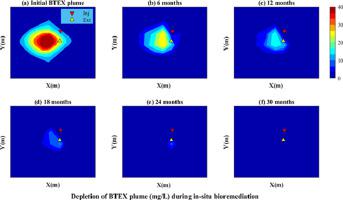当前位置:
X-MOL 学术
›
Adv. Water Resour.
›
论文详情
Our official English website, www.x-mol.net, welcomes your
feedback! (Note: you will need to create a separate account there.)
Optimal design of in-situ bioremediation system using the meshless element-free Galerkin method and particle swarm optimization
Advances in Water Resources ( IF 4.0 ) Pub Date : 2020-10-01 , DOI: 10.1016/j.advwatres.2020.103707 Tinesh Pathania , T.I. Eldho , Andrea Bottacin-Busolin
Advances in Water Resources ( IF 4.0 ) Pub Date : 2020-10-01 , DOI: 10.1016/j.advwatres.2020.103707 Tinesh Pathania , T.I. Eldho , Andrea Bottacin-Busolin

|
Abstract An optimal design of in-situ bioremediation system for contaminated aquifer sites mainly depends on the injection/extraction well locations and their pumping rates. Previous studies have used discretization approaches such as finite difference method (FDM) or finite element method (FEM) to solve the equations of groundwater flow and contaminant transport (GFCT) that characterize the bioremediation processes. In these numerical models, well locations can only lie at the grid nodes and therefore, the locations other than the grid nodes remain unexplored for the optimal in-situ bioremediation. To explore such locations, in this study a meshless simulation model called BIOEFGM is developed using the element-free Galerkin method (EFGM) and coupled with the particle swarm optimization (PSO). BIOEFGM model provides flexibility in adding injection/extraction wells anywhere in the computational domain during the entire optimization procedure. However, FDM/FEM requires meshing and re-meshing of the computational domain for each set of wells and it increases the computational efforts significantly for solving the optimization problem. In this paper, the proposed BIOEFGM-PSO simulation-optimization (S/O) model is first applied to a well-known bioremediation problem and then to a field type large aquifer problem. The simulation results of BIOEFGM are verified with those from the RT3D simulations. The estimated bioremediation cost from the BIOEFGM-PSO model for the first problem is found to be lesser in comparison to the same calculated with different S/O models in the previous studies. The results of this problem also show that optimized in-situ bioremediation system designed by proposed S/O model takes less remediation time and also favor effective biodegradation of contaminants. For both the problems, BIOEFGM-PSO identified optimal well locations at positions other than that of discretized nodes and it leads to efficient bioremediation. It indicates the effectiveness of the BIOEFGM-PSO model and therefore, can be applied for designing the better optimized in-situ bioremediation systems for field problems.
中文翻译:

使用无网格无单元伽辽金法和粒子群优化原位生物修复系统的优化设计
摘要 污染含水层原位生物修复系统的优化设计主要取决于注入/抽取井的位置及其抽水量。以前的研究使用离散化方法,如有限差分法 (FDM) 或有限元法 (FEM) 来求解表征生物修复过程的地下水流和污染物迁移 (GFCT) 方程。在这些数值模型中,井位只能位于网格节点处,因此,对于最佳原位生物修复,网格节点以外的位置仍未探索。为了探索这些位置,在本研究中,使用无元素伽辽金方法 (EFGM) 并结合粒子群优化 (PSO) 开发了一种称为 BIOEFGM 的无网格仿真模型。BIOEFGM 模型提供了在整个优化过程中在计算域中的任何位置添加注入/抽取井的灵活性。然而,FDM/FEM 需要对每组井的计算域进行网格划分和重新划分网格,这显着增加了解决优化问题的计算工作量。在本文中,提出的 BIOEFGM-PSO 模拟优化 (S/O) 模型首先应用于众所周知的生物修复问题,然后应用于现场类型的大型含水层问题。BIOEFGM 的模拟结果与 RT3D 模拟的结果进行了验证。发现第一个问题的 BIOEFGM-PSO 模型估计的生物修复成本与之前研究中使用不同 S/O 模型计算的相同成本相比要低。该问题的结果还表明,由所提出的 S/O 模型设计的优化原位生物修复系统需要更少的修复时间,并且有利于污染物的有效生物降解。对于这两个问题,BIOEFGM-PSO 在离散节点以外的位置确定了最佳井位,从而实现了有效的生物修复。它表明 BIOEFGM-PSO 模型的有效性,因此可用于设计更好的优化原位生物修复系统以解决现场问题。
更新日期:2020-10-01
中文翻译:

使用无网格无单元伽辽金法和粒子群优化原位生物修复系统的优化设计
摘要 污染含水层原位生物修复系统的优化设计主要取决于注入/抽取井的位置及其抽水量。以前的研究使用离散化方法,如有限差分法 (FDM) 或有限元法 (FEM) 来求解表征生物修复过程的地下水流和污染物迁移 (GFCT) 方程。在这些数值模型中,井位只能位于网格节点处,因此,对于最佳原位生物修复,网格节点以外的位置仍未探索。为了探索这些位置,在本研究中,使用无元素伽辽金方法 (EFGM) 并结合粒子群优化 (PSO) 开发了一种称为 BIOEFGM 的无网格仿真模型。BIOEFGM 模型提供了在整个优化过程中在计算域中的任何位置添加注入/抽取井的灵活性。然而,FDM/FEM 需要对每组井的计算域进行网格划分和重新划分网格,这显着增加了解决优化问题的计算工作量。在本文中,提出的 BIOEFGM-PSO 模拟优化 (S/O) 模型首先应用于众所周知的生物修复问题,然后应用于现场类型的大型含水层问题。BIOEFGM 的模拟结果与 RT3D 模拟的结果进行了验证。发现第一个问题的 BIOEFGM-PSO 模型估计的生物修复成本与之前研究中使用不同 S/O 模型计算的相同成本相比要低。该问题的结果还表明,由所提出的 S/O 模型设计的优化原位生物修复系统需要更少的修复时间,并且有利于污染物的有效生物降解。对于这两个问题,BIOEFGM-PSO 在离散节点以外的位置确定了最佳井位,从而实现了有效的生物修复。它表明 BIOEFGM-PSO 模型的有效性,因此可用于设计更好的优化原位生物修复系统以解决现场问题。









































 京公网安备 11010802027423号
京公网安备 11010802027423号